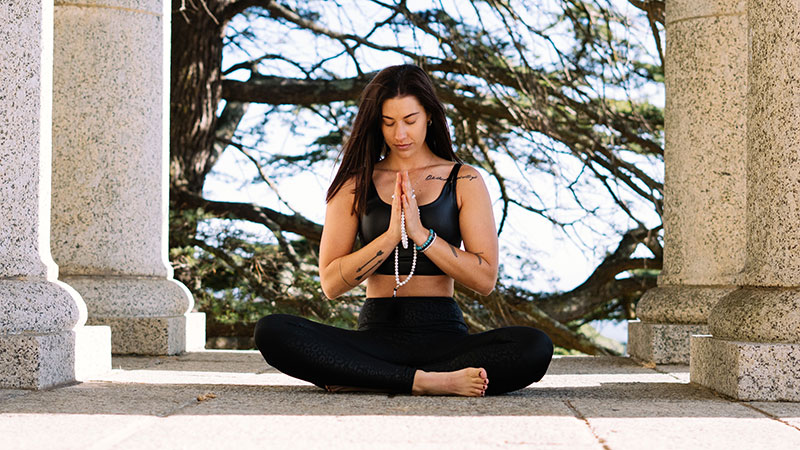Yoga. When you mention this word, most people imagine a form of exercise — sometimes sweaty, sometimes calm, but usually done on a yoga mat. If you attend a class in a yoga studio instead of a gym, there might be a bit more focus on mindfulness and breathing.
The boom of quick yoga teacher training courses has meant that quality of teaching is often unpredictable. Ideally, yoga teachers should study the subject of yoga in depth and try to pass on that knowledge and their experience to their students.
Unfortunately, it is not always easy to find a teacher who will do that, so in this article, we want to give you some practical suggestions as to how to improve your yoga practice. Yoga is far from a form of physical exercise. In fact, you can practice yoga without ever doing a single physical pose. Practicing your body physically is just a yogic tool to help you turn inwards. If your body feels unwell or aches, you will never be able to focus on your spiritual development. For that reason, yoga tradition asks you to first purify your behaviour towards others and towards yourself and subsequently to purify your body and your breathing. Only then are you able to sit in silence, withdraw from the external world and focus on your internal self.
This means that if you don’t meditate, you are essentially missing the whole point of yoga. Meditation isn’t just a next step to be completed after you master physical poses. To the contrary; your asana practice and meditation go hand in hand, and it will benefit you much more if you start building your meditation practice from the very beginning.

It is important to mention that silent mediation is not the only form of meditation; there are many styles and techniques of meditation, and different people will respond differently to them. For someone, sitting in silence and focusing on quieting the mind works really well. Someone else will find it much more relaxing to chant mantras. The best approach is to try out a variety of meditation techniques and then build your practice with the ones that you felt were helpful for you.
If you are ready to take up the challenge of silent meditation, here are some tips and tricks which might help you:
1. Sit down with your spine straight
The practical reason for keeping your spine straight is simple. If you lay down in bed, you might get sleepy and struggle to focus on meditation. Similarly, if you sit on a couch and twist your back, you’re sending signals to your body that it’s chill time and nothing serious is going on. But the fact is that in order to meditate, you need to be as alert as possible. For that reason, it is important to keep your spine straight.
If you’re more interested in the yogic tradition, then the philosophy says that energy or life force is moving from our base chakra upwards along the spine, and meditation strengthens this process. If you physically distort this energy flow, you are significantly hindering your meditation practice.
2. Start with your breath
Alright, so you’re sitting down with your spine straight. What now? If you’re a beginner in meditation, it might feel really awkward to sit alone in silence.
The simplest tool is this: focus on your breath. That’s all you need to do, and for a start, you don’t even have to follow the next steps.
Take deep inhales and exhales through your nose. With each inhale, focus on the air moving inside your lungs, your chest rising, oxygen coming into your body. With each exhale, focus on the air coming out of your nostrils, your chest compressing, toxins leaving your body. Notice every single thing, every sensation about your breath. This practice will make you focused.
3. Notice your surroundings
If you want to continue with your meditation practice beyond focusing on your breath, the best method for me is to move my attention gradually from the external to the internal.
The first step, therefore, is to notice everything around you. Listen to each sound carefully, whether it comes from a large distance or it is quite close to you. Notice the air — can you feel the breeze? Can you smell anything? Notice what you’re sitting or lying on. If you’re on the ground, feel the hardness. If you’re on your bed or a cushion, feel the soft sensation.
Most importantly, throughout your meditation practice, don’t judge or evaluate. Don’t label anything as good or bad. Your task is to be an observer, a witness.

4. Pay attention to your body
Next, from the world around you, move on to your physical body. Scan your body slowly from head to toes. Is anything hurting? Is there any sensation that stands out? Are you tired or is your energy level high? Are there any body parts that you don’t usually pay much attention to? Visually imagine each body part that you’re inspecting.
5. Pay attention to your emotional body
Next, move on to your emotions. Notice how you feel. Notice that you might not be immediately sure about how you feel — we are so disconnected from ourselves that we often aren’t able to describe our emotions. That’s ok. Just give it a go. Maybe there is a mixture of feelings. Maybe you’ve been feeling emotionally drained for some time but something made you really happy today and now you’re feeling both! Emotions are really complex so anything is possible.
Again, don’t evaluate or judge. There’s nothing inherently bad in feeling sad or anxious. These feelings belong to the same category as joy or excitement. They are just emotions, and emotions come and go. You also shouldn’t feel guilty for having a certain type of emotion. Accept your emotional state, no matter what it looks like right now. Be non-reactive; your role is only to observe
6. Pay attention to your mind
After you’ve examined your emotional state, you can move to your mind. Watch your mind as a distant observer. There are probably many thoughts chaotically appearing and then running away in all possible directions.
The first step is just to realise this. Your mind is not your thoughts. Your mind is a clear blue sky, and thoughts are clouds covering it. Imagine yourself lying on the grass on a sunny day, observing the clouds in the sky. Then observe your thoughts in a similar way.
Initially, try to distinguish the individual thoughts. Can you realize where one ends and another one begins? Can you watch them passing through your mind as the clouds pass through the sky?
Try not to engage with the thoughts; just observe them enter your mind and leave. But, at the same time, don’t beat yourself up for accidentally engaging with your thoughts; we are so used to doing this that it happens automatically. So, if you realise half-way through your meditation practice that you are planning what you will have for lunch the next day, congratulate yourself for noticing this, let the thought go and return to the position of an unengaged observer.

7. Try to stay in the gap between thoughts
This is the ultimate goal of meditation. Once you practise the previous step sufficiently and gain control over your thoughts (mind you, this can take months or even years), you will start noticing that the stream of thoughts is not continuous. One thought leaves, and before another one comes, there is a gap. A small glimpse of silence, or nothingness. This is the clear blue sky that the clouds have been hiding for so long. Gradually, you will be able to prolong the gaps between thoughts.
For yoga masters, this gap between thoughts becomes the state of being. Thoughts disappear, the internal chattering of the mind is gone. The mind is not engaged with its own activity but rather exists in a state of calm and absolute awareness. This is one of the ways to describe Samadhi.
You can adapt this meditation practice into your own routine. If you feel comfortable with one step, you can gradually take on the following one. You can go through all the steps in 10 minutes, or you can sit in silence for hours. Experiment for yourself.
Whatever style of meditation you will find suitable for you, we hope that this
